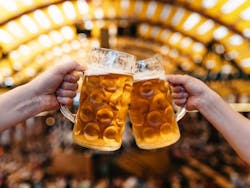In spite of the recent spate of media and political attention to beer drinking, many of us still enjoy an occasional cold 'brewski'. For me, it’s with pizza, while watching college football (especially the Hokies!). Of course October, famous for Oktoberfest, is the perfect time to sample the malt beverages made possible by modern refrigeration (you knew there had to be an HVACR hook in here).
The official Oktoberfest is the oldest and largest beer festival in the world, dating back to 1810, and attracting more than 6 million revelers to Munich, Bavaria, Germany, every fall. It is also widely celebrated outside of Germany, with notable U.S. events held in Reading PA (Reading Leiderkranz Oktoberfest); New Braunfels TX (Wurstfest); La Crosse WI (Oktoberfest U.S.A.); Cincinnati OH (Oktoberfest Zinzinnati); New Ulm MN (New Ulm Oktoberfest); Mount Angel OR (Mount Angel Oktoberfest); Fredericksburg, TX (Oktoberfest Fredericksburg); Frankenmuth MI (Frankenmuth Oktoberfest); Tulsa OK (Linde Oktoberfest Tulsa); and Torrance CA (Alpine Village Oktoberfest).
A regular contributor to HPAC Engineering and a member of its editorial advisory board, the author is a principal at Sustainable Performance Solutions LLC, a south Florida-based engineering firm focusing on energy and sustainability.
About the Author
Larry Clark
A member of HPAC Engineering’s Editorial Advisory Board, Lawrence (Larry) Clark, QCxP, GGP, LEED AP+, is principal of Sustainable Performance Solutions LLC, a South Florida-based engineering firm focused on energy and sustainability consulting. He has more than two dozen published articles on HVAC- and energy-related topics to his credit and frequently lectures on green-building best practices, central-energy-plant optimization, and demand-controlled ventilation.

